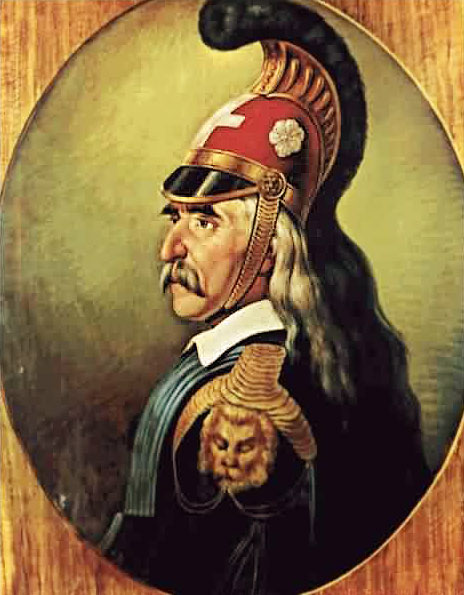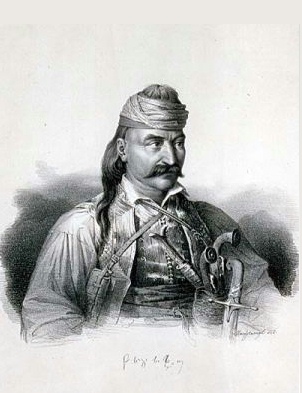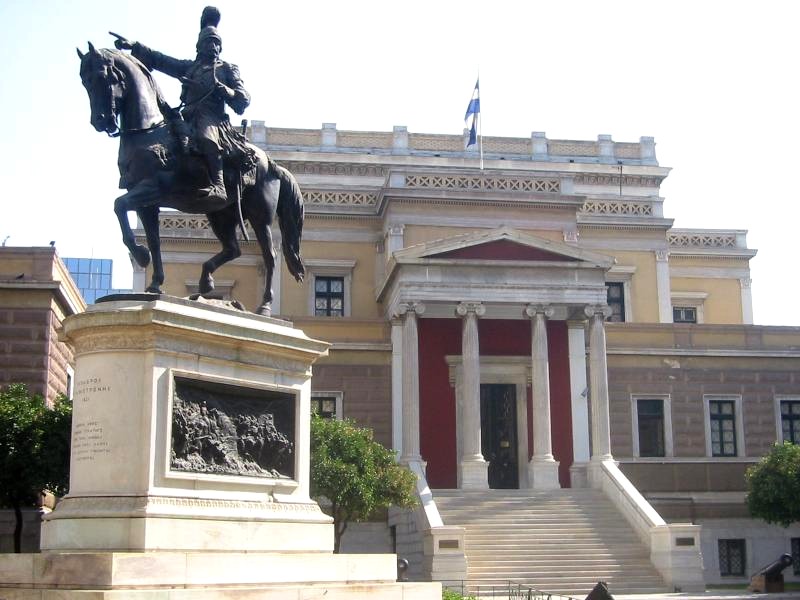<Back to Index>
- Ornithologist George Edwards, 1694
- Cartoonist Harry Conway "Bud" Fisher, 1885
- Greek Revolutionary General Theodoros Kolokotronis, 1770
PAGE SPONSOR


Theodoros Kolokotronis (Greek: Θεόδωρος Κολοκοτρώνης) (3 April 1770 – 15 February 1843) was a Greek general and one of the leaders of the Greek War of Independence against the Ottoman Empire.
Kolokotronis' greatest success was the
defeat of the Ottoman army under Mahmud
Dramali Pasha at Dervenakia in 1822. In 1825, he was appointed
commander-in-chief of the Greek forces in the Peloponnese. Today Kolokotronis is among the most
revered of the protagonists of the War of Independence. The Kolokotroneoi were a powerful and
respected clan in Arcadia in the 18th century. Their
legendary pride and insubordination is commemorated in a well-known
folk song from that time:
Ahorse
they go to church, Kolokotronis
was born at Ramavouni in Messenia,
and grew up in Libovitsi in Arcadia.
His father, Constantine
Kolokotronis, took part in an armed rebellion which was
supported by Catherine the
Great of Russia,
but was killed in an engagement along with two of his brothers George
and Harry. Theodoros joined
the ranks of a Peloponnesian guerrilla band, and by age fifteen was the
leader (kapetanios, which means "captain") of his own group. He
had a brief stint at sea as a corsair,
then in 1805 he took service on a series of ships in the Russian fleet in the Russo-Turkish
War. After 1810 he served in a corps of Greek infantry in
English service on Zakynthos,
then a British possession, and was awarded the brevet rank of brigadier for his service against the
French.
From
his service in the regular Russian and British forces,
Kolokotronis gained valuable insights that he would later use in his
career. Kolokotronis
returned
to the mainland just prior to the outbreak of the war
(officially, 25 March 1821) and formed a confederation of irregular
Moreot klepht bands. These he tried to
train and organize into something resembling a modern army. In May, he
was named archistrategos or Marshal
Commander-in-Chief. He was already 50 years old by this time, a fact
which contributed to his sobriquet O
Geros tou Morea or
"The Elder of Moreas," whereby Morea was another name describing
the Peloponnese.
Kolokotronis' first action was the defense of Valtetsi,
the village near Tripoli where his army was
mustering. He
next commanded Greek troops in the siege of the coastal town of Nafplion.
He
took the port, and the Turkish garrison in the town's twin citadels
was running low on supplies, but the disorganized Greek provisional
government at Argos,
just to the north, could not complete negotiations for its surrender
before a large Ottoman force began marching southward to crush the
rebels. Panicked, government officials abandoned Argos and began
evacuations by sea at Nafplion. Only an under-strength battalion under Demetrios
Ypsilantis remained
to hold Larissa castle, the fortress of Argos. Kolokotronis
gathered
the klephts together to march to the relief of Ypsilantis.
This was quite a feat in itself, considering the near-collapse of the
government and the notoriously quarrelsome nature of the klephtic
bands. Even the troublesome Souliotes lent a hand. The Ottoman army
from the north commanded by Mahmud Dramali
Pasha, after taking Corinth,
had marched to the plain of Argos. The castle of Larissa was an
excellent position, commanding the whole plain. To leave such a
stronghold straddling Turkish supply lines was far too dangerous.
Dramali would have to reduce the fortress before moving on. Scaling the
cliffs, breaching the castle's stout walls, and overcoming its resolute
defenders would be no easy task. Yet, there was one weakness Dramali
was unaware of: Larissa, unlike the famous Acropolis in Athens, had no spring
and consequently fresh water had to be supplied from cisterns.
Unfortunately
for the Greeks, it was July and no rains were falling to
fill the cisterns. Ypsilantis bluffed the Turks as long as he could,
but towards the end of the month had to sneak his men out in the middle
of the night. Dramali's men plundered the castle the next day, and he
was now free to march them toward the coast to resupply. (The Greeks
had pursued a scorched earth
policy,
and the large Ottoman force was eating through its food supplies rather
quickly). Ypsilantis' defense had bought Kolokotronis and the klephts
valuable time. To his dismay, Dramali found himself cut
off from his supply fleet, which had intended to land at Nafplio but
was successfully blockaded by the Greek fleet under Admiral Andreas
Miaoulis. Dramali reluctantly
decided upon a retreat toward Corinth through the Dervenaki Pass,
through which he had just come unmolested. This was exactly what
Kolokotronis had been hoping for. In August 1822 his quicker-moving
guerrilla forces trapped the Turks in the pass and annihilated them. A
devastated Sultan Mahmud
II in Constantinople was forced to turn to Muhammad
Ali, ruler of the nominally
Ottoman pashaluk of Egypt for help. The
Greeks
resumed the siege against the fortresses at Nafplio, which fell
in December. Kolokotronis is said to have ridden his horse up the steep
slopes of Kastro Palamidi to
celebrate his victory there; a statue in the town square commemorates
the event. He is attired in something resembling the costume of a hussar topped with a plumed Corinthian
helmet, which he was fond of wearing, and which foreign Philhellenes were even fonder of seeing
him in. (While he seems to have enjoyed dressing like a Western
European cavalryman cum Ancient Greekhoplite,
he is also frequently depicted wearing the more traditional fustanella and other traditional
accoutrements). Later
in the same year, Kolokotronis's political enemies in the Greek
provisional government, led by Petrobey
Mavromichalis, had him imprisoned in the Palamidi with Dimitris
Plapoutas in the
same jail,
but he was released when an Egyptian army under the command of Ibrahim Pasha invaded
the Morea. Ibrahim was fresh from
fighting the Wahhabi rebels in Arabia,
and so was used to fighting guerrillas. His troops were armed with the
most modern equipment and trained by European experts. The sultan had
promised his father the island of Crete as an appanage for
young Ibrahim if he could crush the rebels. With his eye on the prize,
he burned his way through the Peloponnese, gaining much territory but
arousing much hostility in Western European public opinion,
which in the long run proved disastrous for the Turks.
The island of Sphacteria and Navarino had
already fallen into Ibrahim's hands, and to make matters worse for
Kolokotronis, he still had to be on guard against the machinations of
Petrobey Mavromichalis even as he was bracing himself against the new
threat. Kolokotronis used guerrilla tactics to wear Ibrahim's forces
down; but given his limited resources, was unable to prevent the
widespread destruction that Ibrahim left in his wake. Still, in 1825,
in recognition of his military acumen and many services to the Greek
cause, he was appointed commander-in-chief of Greek forces in the
Peloponnese. After
the war Kolokotronis became a supporter of Count Ioannis
Kapodistrias and
a proponent of alliance with Russia.
When the count was assassinated on 8 October 1831, Kolokotronis created
his own administration in support of Prince Otto of
Bavaria as a
king of Greece. However, later he opposed the Bavarian
dominated regency during
his rule. He was charged with treason and on 7 June 1834
sentenced to death; but he was pardoned in 1835. Theodoros Kolokotronis
died in 1843 in Athens one day after his son's
Nicholas wedding. In
the twilight of his life, Kolokotronis had learned to write in order to
complete his memoirs,
which have been a perennial favorite in Greece and have been several
times translated into English and other languages. Kolokotronis' famed
helmet, along with the rest of his arms and armor, may today be seen in
the National History Museum of Greece in Athens. In addition to the
Nafplio statue mentioned earlier, there is another to be seen in
Athens, in the forecourt of the Old Parliament
building on Stadiou Street,
near Syntagma Square. Kolokotronis
is honored by many street names. One of
them in the populated cities is Kolokotroni
Street in Patras.
Kolokotronis is also the name of military barracks near Tripolis. Kolokotronis' portrait was depicted on
the obverse of the Greek 5000 drachmas banknote of 1984 - 2001.
Ahorse they kiss the icons,
Ahorse they receive communion
From the priest's hand.

